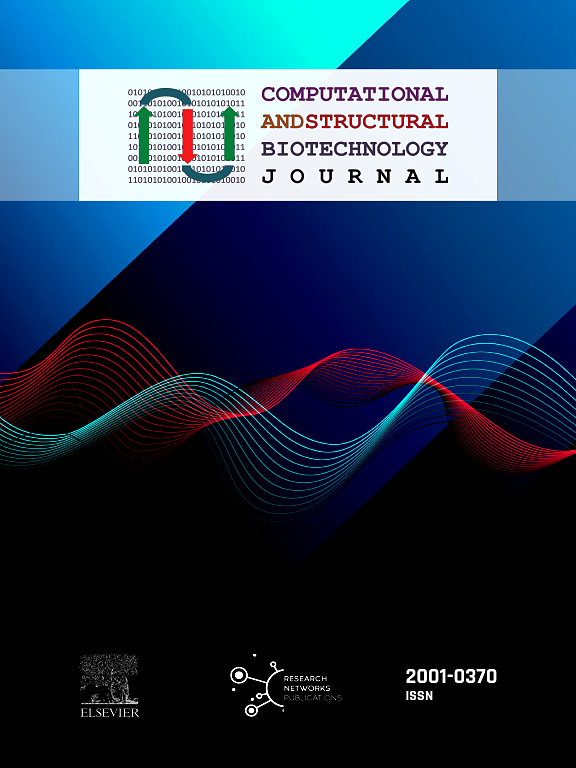针对耐碳青霉烯类鲍曼不动杆菌的多粘菌素和可乐定/舒巴坦联合疗法的转录组学研究
IF 4.4
2区 生物学
Q2 BIOCHEMISTRY & MOLECULAR BIOLOGY
Computational and structural biotechnology journal
Pub Date : 2024-05-31
DOI:10.1016/j.csbj.2024.05.043
引用次数: 0
摘要
耐碳青霉烯类抗生素(CRAB)是第一优先(危重)病原体,急需新的抗生素。多粘菌素是治疗 CRAB 相关感染的最后选择。本转录组学研究利用 CRAB 菌株研究多粘菌素 B、可乐定、可乐定 B 和可乐定/舒巴坦联合疗法的杀菌机制。在 2 毫克/升多粘菌素单药治疗 4 小时后,所有多粘菌素都表现出共同的转录组反应,主要涉及氨基酸和脂肪酸代谢的破坏。在三种单一疗法中,多粘菌素 B 诱导的差异表达基因(DEGs)数量最多,其中包括与脂肪酸代谢有关的基因。单用秋水仙素(2 毫克/升)或与舒巴坦(64 毫克/升)联用会导致膜在 1 小时内迅速破坏。对这种联用疗法的转录组分析表明,其影响是由秋水仙素驱动的,包括脂肪酸合成和分解代谢的紊乱以及营养吸收的抑制。与单一疗法相比,联合疗法在 72% 的 DEGs 中产生了更高的折叠变化,导致脂肪酸生物合成大幅减少,生物膜、细胞壁和磷脂合成增加。这表明秋水仙素/舒巴坦联合疗法的协同杀菌效果来自于与细菌新陈代谢相关的许多基因受到系统性干扰的增加。这些机理方面的见解加深了我们对细菌对多粘菌素单一疗法和联合疗法反应的了解,有助于优化多粘菌素在患者中的使用。本文章由计算机程序翻译,如有差异,请以英文原文为准。

Transcriptomic investigations of polymyxins and colistin/sulbactam combination against carbapenem-resistant Acinetobacter baumannii
Carbapenem-resistant (CRAB) is a Priority 1 (Critical) pathogen urgently requiring new antibiotics. Polymyxins are a last-line option against CRAB-associated infections. This transcriptomic study utilized a CRAB strain to investigate mechanisms of bacterial killing with polymyxin B, colistin, colistin B, and colistin/sulbactam combination therapy. After 4 h of 2 mg/L polymyxin monotherapy, all polymyxins exhibited common transcriptomic responses which primarily involved disruption to amino acid and fatty acid metabolism. Of the three monotherapies, polymyxin B induced the greatest number of differentially expressed genes (DEGs), including for genes involved with fatty acid metabolism. Gene disturbances with colistin and colistin B were highly similar (89 % common genes for colistin B), though effects on gene expression were generally lower (0–1.5-fold in most cases) with colistin B. Colistin alone (2 mg/L) or combined with sulbactam (64 mg/L) resulted in rapid membrane disruption as early as 1 h. Transcriptomic analysis of this combination revealed that the effects were driven by colistin, which included disturbances in fatty acid synthesis and catabolism, and inhibition of nutrient uptake. Combination therapy produced substantially higher fold changes in 72 % of DEGs shared with monotherapy, leading to substantially greater reductions in fatty acid biosynthesis and increases in biofilm, cell wall, and phospholipid synthesis. This indicates synergistic bacterial killing with the colistin/sulbactam combination results from a systematic increase in perturbation of many genes associated with bacterial metabolism. These mechanistic insights enhance our understanding of bacterial responses to polymyxin mono- and combination therapy and will assist to optimize polymyxin use in patients.
求助全文
通过发布文献求助,成功后即可免费获取论文全文。
去求助
来源期刊

Computational and structural biotechnology journal
Biochemistry, Genetics and Molecular Biology-Biophysics
CiteScore
9.30
自引率
3.30%
发文量
540
审稿时长
6 weeks
期刊介绍:
Computational and Structural Biotechnology Journal (CSBJ) is an online gold open access journal publishing research articles and reviews after full peer review. All articles are published, without barriers to access, immediately upon acceptance. The journal places a strong emphasis on functional and mechanistic understanding of how molecular components in a biological process work together through the application of computational methods. Structural data may provide such insights, but they are not a pre-requisite for publication in the journal. Specific areas of interest include, but are not limited to:
Structure and function of proteins, nucleic acids and other macromolecules
Structure and function of multi-component complexes
Protein folding, processing and degradation
Enzymology
Computational and structural studies of plant systems
Microbial Informatics
Genomics
Proteomics
Metabolomics
Algorithms and Hypothesis in Bioinformatics
Mathematical and Theoretical Biology
Computational Chemistry and Drug Discovery
Microscopy and Molecular Imaging
Nanotechnology
Systems and Synthetic Biology
 求助内容:
求助内容: 应助结果提醒方式:
应助结果提醒方式:


